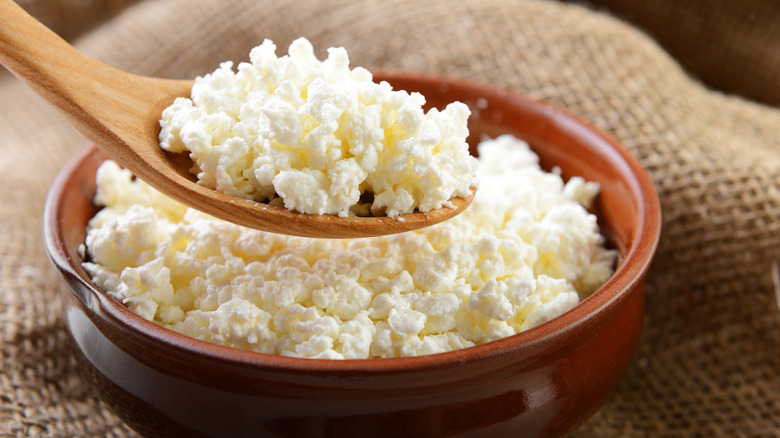How Cottage Cheese Gets Those Distinct Creamy Curds
No longer just a diet food of the 1950s, cottage cheese today is used to add creaminess to scrambled eggs and egg salad, heartiness to ranch dip, and protein to ice cream. But it wasn't always a beloved dairy product. One reason the cheese fell out of favor after the 1970s had to do with its lumpy quality, which was seen as unappealing at the time. The resurgence of cottage cheese either has us embracing those bumps or blending the dairy product to produce a smooth texture. But why exactly does the fromage have those distinct curds, anyway?
Cottage cheese goes through a production process that starts off like most other cheeses: combining pasteurized milk with an acid (typically vinegar or live cultures), which isolates curds from the whey. If you're not familiar with cheese making, whey is the murky, protein-packed liquid that's left when the solid particles are strained out. When the acid is mixed into the milk, the combination produces lactic acid, which results in the milk proteins curdling and forming clumps. But unlike with other types of cheese (like cheddar and Brie), the curds in cottage cheese aren't molded together to produce a solid block or wheel. Instead, they're simply cut into pieces, rinsed, and sprinkled with a little salt. The curds can be cut into small or large chunks, but either method allows even more of the whey to drain out.
How the curds differentiate cottage cheese from other types
Because cottage cheese doesn't have to be aged or ripened, the process for making it is typically much simpler than for other types of cheese. As a result, it has a milder flavor, which is only slightly tangy and sweet. However, the curds can also be flavored with herbs, seasonings, olive oil, and even honey or jam. And as we know, its otherwise bland flavor makes it an ideal creamy ingredient for a wide range of recipes.
The other advantage that the unique curd-making process gives cottage cheese is the same reason that it became a revered diet food in the past century. Since this type of cheese is composed almost entirely of the proteins in milk (called casein), you're getting the most bang for your buck nutrition-wise. It's also typically made from low fat or nonfat milk, so the curds will have a much lower fat content than other types of cheese. Some versions have a little cream added to them, but even then, cottage cheese will contain about 4% fat. Compare this to cheddar, which is made up of 30% fat. So, while the lumps in cottage cheese may look a little unappetizing at first sight, you're really just getting a young version of cheese that's low in fat and high in protein.

